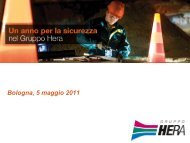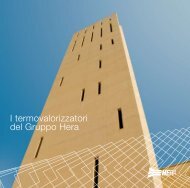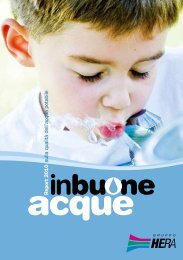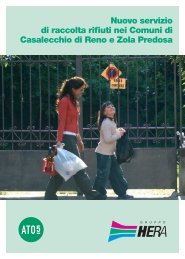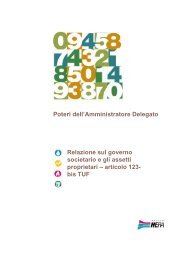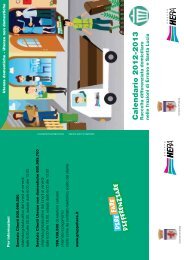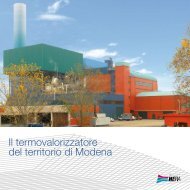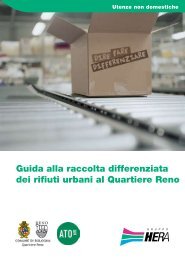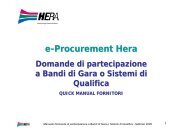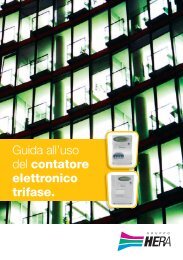Brochure Teleriscaldamento - Il Gruppo Hera
Brochure Teleriscaldamento - Il Gruppo Hera
Brochure Teleriscaldamento - Il Gruppo Hera
Create successful ePaper yourself
Turn your PDF publications into a flip-book with our unique Google optimized e-Paper software.
divisione<br />
teleriscaldamento<br />
district heating<br />
division
divisione teleriscaldamento<br />
Volumetria Servita<br />
Volumes Served: 16.010.000 mc<br />
Energie rinnovabili e di recupero<br />
Renewable and recovered energy: 42%<br />
La Divisione <strong>Teleriscaldamento</strong><br />
<strong>Il</strong> <strong>Gruppo</strong> <strong>Hera</strong> è una delle più importanti multiutility<br />
italiane che opera nei servizi dell’ambiente, dell’acqua<br />
e dell’energia (distribuzione e vendita di gas metano<br />
ed energia elettrica e teleriscaldamento). <strong>Il</strong> suo modello<br />
imprenditoriale originale e la sua gestione attenta<br />
e sostenibile delle risorse l’hanno portata a rivestire<br />
un ruolo di primo piano tra i leader nazionali del settore<br />
anche per quel che riguarda la capacità di innovazione<br />
nel rispetto dell’ambiente.<br />
<strong>Il</strong> ruolo rivestito dalla Divisione in quest’ambito<br />
è fondamentale.<br />
<strong>Il</strong> teleriscaldamento è infatti un servizio completo<br />
già ampiamente utilizzato in tutta Europa che fornisce<br />
direttamente, senza necessità di trasformazioni,<br />
l’energia termica necessaria alla casa, all’ufficio ed alle<br />
altre attività della vita quotidiana (scuole, ospedali,..).<br />
L’energia da teleriscaldamento, per raggiungere<br />
la migliore efficienza possibile ed il minore inquinamento,<br />
viene prodotta grazie a tecnologie all’avanguardia.<br />
La Divisione <strong>Teleriscaldamento</strong> si occupa,<br />
in collegamento con le altre realtà aziendali,<br />
di organizzare, presidiare e coordinare tutte<br />
le attività operative e di sviluppo relative ai sistemi<br />
di teleriscaldamento con l’obiettivo di razionalizzarne<br />
gli interventi e perseguire standard sempre più elevati<br />
di efficienza e redditività.<br />
Dal progetto alle verifiche di fattibilità, dagli sviluppi<br />
alla realizzazione della rete di teleriscaldamento fino alla<br />
sua messa in esercizio, la Divisione <strong>Teleriscaldamento</strong> è<br />
in grado di seguire Amministrazioni, Enti Territoriali<br />
e cittadini per supportarli nell’utilizzo di questo servizio<br />
innovativo.<br />
Inoltre una delle caratteristiche principali della Divisione<br />
<strong>Teleriscaldamento</strong> del <strong>Gruppo</strong> <strong>Hera</strong> è quella di avere<br />
l’opportunità di massimizzare l’energia di recupero che,<br />
grazie alla rete di impianti del <strong>Gruppo</strong>, la Divisone ha<br />
a sua disposizione. <strong>Il</strong> teleriscaldamento ben utilizzato<br />
diventa infatti uno strumento integrato con lo sviluppo<br />
urbanistico, capace di valorizzare le energie rinnovabili,<br />
permettere un effettivo risparmio e soddisfare<br />
la crescente domanda energetica tutelando l’ambiente,<br />
ottimizzando le materie prime e assicurando un futuro<br />
sostenibile.<br />
11%<br />
13%<br />
Quadro di riferimento al<br />
31/12/2008<br />
17%<br />
1%<br />
Mix delle fonti per teleriscaldamento<br />
Recupero da CCGT<br />
Cogenerazione a gas<br />
Geotermia<br />
Recupero da WTE<br />
Caldaie a gas<br />
58%<br />
2
district heating division<br />
Energia Elettrica Prodotta<br />
Electricity Produced: 74 GWhe<br />
Energia Termica Prodotta<br />
Thermal Energy Produced: 495 GWht<br />
The District Heating Division<br />
The <strong>Hera</strong> Group is one of the most important Italian<br />
multiutility companies operating in environmental<br />
services, water and energy (distribution and sale of<br />
methane gas, electricity and district heating). <strong>Hera</strong>’s<br />
original business model and its careful and sustainable<br />
management of resources have resulted in its becoming<br />
one of the national leading companies in its sector.<br />
This is also true for its capacity for innovation and the<br />
respect of environment.<br />
The District Heating Division plays a fundamental role in<br />
this area.<br />
District heating is a complete service and is already<br />
widely used throughout Europe. It directly supplies<br />
thermal energy, without further transformation being<br />
required, to homes, offices and other buildings used<br />
daily (schools, hospitals etc.). To achieve the best<br />
possible efficiency and the lowest levels of pollution,<br />
district heating energy is produced using the very latest<br />
technologies.<br />
In addition, the principal characteristic of the <strong>Hera</strong><br />
Group’s District Heating Division is the capability<br />
to maximise the recovered energy leveraging upon<br />
a wide network of plants. Properly used, district<br />
heating becomes an instrument integrated with<br />
urban development, capable of leveraging renewable<br />
energies, enabling effective savings and meeting rising<br />
energy demand, while also protecting the environment,<br />
optimising raw materials and ensuring a sustainable<br />
future.<br />
11%<br />
Reference framework as at<br />
31/12/2008<br />
17%<br />
Together with the other company divisions, the District<br />
Heating Division organises, operates and coordinates<br />
all operations and development concerning the district<br />
heating systems, aiming to rationalise interventions and<br />
pursue ever-higher standards in terms of efficiency and<br />
profitability.<br />
Design, feasibility studies, developing and building the<br />
district heating network and even laying the connections:<br />
the District Heating Division has the resources to<br />
interface with administrations, regional bodies and the<br />
retail customers, to support them in the use of this<br />
innovative service.<br />
13%<br />
1%<br />
Disctric heating procurement mix<br />
Energy CCGT<br />
Gas fired cogeneration plants<br />
Geothermal<br />
Energy recovery from WTE<br />
Domestic gas fired system<br />
58%<br />
3
divisione teleriscaldamento<br />
Sistema energetico integrato<br />
La Divisione <strong>Teleriscaldamento</strong>, grazie alla sua presenza<br />
sul territorio ed all’appartenenza al <strong>Gruppo</strong> <strong>Hera</strong>, è in<br />
grado di operare secondo un sistema energetico<br />
integrato.<br />
ll <strong>Gruppo</strong> <strong>Hera</strong> favorisce infatti iniziative di recupero<br />
energetico attraverso impianti di termovalorizzazione<br />
rifiuti, produzione di energia da biogas, impianti<br />
di cogenerazione ed impianti alimentati da fonti<br />
rinnovabili (geotermia), pompe di calore alimentate<br />
con le acque recuperate.<br />
La vasta disponibilità di impianti dislocati sul territorio<br />
fa sì che la Divisione <strong>Teleriscaldamento</strong> possa operare<br />
diversificando le fonti di approvvigionamento<br />
e cogliendo, per ogni progetto, le opportunità specifiche<br />
che quel territorio presenta limitando al minimo l’utilizzo<br />
di energie primarie. Inoltre il sistema prevede<br />
una vera gestione integrata del sistema energetico<br />
ed ambientale in ambito urbano, in sinergia con<br />
le azioni delle Amministrazioni Locali e con gli strumenti<br />
di Pianificazione Locale, con un’attenzione particolare<br />
alla scelta e all’ottimizzazione delle fonti e della<br />
tecnologia di produzione. <strong>Il</strong> sistema energetico integrato<br />
opera quindi all’insegna della sostenibilità, permettendo<br />
un risparmio ambientale ed anche economico. Infatti,<br />
oltre a ridurre le emissioni di CO2, grazie al recupero<br />
energetico limita i costi energetici.<br />
<strong>Il</strong> sistema energetico integrato di teleriscaldamento<br />
urbano rappresenta un’importante opportunità<br />
per un uso intelligente dell’energia e un grande<br />
contributo per la riduzione dell’inquinamento locale.<br />
La Divisione <strong>Teleriscaldamento</strong> ha al suo interno<br />
personale di grande professionalità, tecnici esperti<br />
capaci di seguire il progetto in ogni sua fase,<br />
adattandolo sulle diverse esigenze per ottimizzare<br />
l’utilizzo della tecnologia per il riscaldamento di fabbricati<br />
e la produzione di acqua calda sanitaria in sostituzione<br />
delle normali caldaie, spesso alimentate a gasolio<br />
o a metano, permettendo di utilizzare centrali<br />
più efficienti e meglio controllate rispetto<br />
alle caldaie domestiche.<br />
20%<br />
Sviluppo piano industriale<br />
2008-2011<br />
17%<br />
11%<br />
Biogas<br />
Recupero da WTE<br />
Recupero da CCGT<br />
Geotermia<br />
COGE a gas<br />
Caldaie a gas<br />
19%<br />
31%<br />
2%<br />
Mix delle fonti per teleriscaldamento<br />
4
district heating division<br />
Integrated energy system<br />
Thanks to its tight link to the region, the District Heating<br />
Division is capable of operating as part of the integrated<br />
energy system of <strong>Hera</strong> Group.<br />
The <strong>Hera</strong> Group favours energy recovery initiatives<br />
through waste-to-energy plants, energy production from<br />
biogas, co-generation plants and plants powered by<br />
renewable sources (geothermics), heat pumps powered<br />
by recovered water.<br />
various different needs to optimise the use of the<br />
technology for heating buildings and producing hot<br />
sanitary water in place of conventional boilers, often<br />
powered by diesel or methane, enabling the use of<br />
power plants that are more efficient and better controlled<br />
than domestic boilers.<br />
The vast availability of plants located throughout the<br />
region means that the District Heating Division can<br />
operate by diversifying the sources of provisioning and,<br />
for each project, taking advantage of the opportunities<br />
of each specific area, so limiting the use of primary<br />
energy sources to a minimum. In addition the system<br />
allows true integrated management of the energy<br />
sources, environment and urban development, in<br />
synergy with the actions of Local Administrations and<br />
with the instruments of Local Urbanistic Planning,<br />
with special attention being paid to choosing and<br />
optimising the production sources and technology. Thus<br />
this the integrated system operates to the favour of<br />
sustainability, allowing environmental respect as well as<br />
economic savings. In fact, as well as reducing emissions<br />
of CO2, the energy recovered also limits energy costs.<br />
The integrated urban district heating energy system<br />
represents an important opportunity for intelligent use<br />
of energy and a great contribution to reducing local<br />
pollution.<br />
The District Heating Division has highly professional<br />
personnel, experienced technicians capable of<br />
managing every phase of the project, adapting it to<br />
20%<br />
Industrial plan development<br />
2008-2011<br />
17%<br />
31%<br />
2%<br />
11%<br />
19%<br />
Disctric heating procurement mix<br />
Biogas<br />
Energy recovery from WTE<br />
Energy recovery from CCGT<br />
Geothermal<br />
Gas fired cogeneration plants<br />
Domestic gas fired system<br />
5
divisione teleriscaldamento<br />
Una rete intelligente<br />
di Distretti Energetici<br />
Per la realizzazione effettiva delle politiche di sviluppo<br />
del teleriscaldamento in ambito urbano è necessario<br />
attuare lo sviluppo tecnologico di supporti informatici<br />
di eccellenza, in grado di ottimizzare la gestione<br />
integrata delle fonti nell’ambito dei singoli distretti<br />
energetici. La Divisione <strong>Teleriscaldamento</strong> è fortemente<br />
impegnata nello sviluppo di reti energetiche intelligenti,<br />
in grado di garantire l’ottimizzazione della integrazione<br />
tra poli di generazione distribuita, reti di distribuzione<br />
ed utenze nell’ambito di un Distretto Energetico<br />
alimentato con il teleriscaldamento. L’obiettivo è disporre<br />
di tecnologie di sistema innovative con un modello<br />
di reti intelligenti efficaci ed efficienti in grado di dare<br />
un sostengo ad uno sviluppo sostenibile del territorio<br />
di riferimento. Lo strumento dei Distretti Energetici dotati<br />
di teleriscaldamento è inoltre altamente efficace<br />
per il raggiungimento degli obiettivi vincolanti fissati<br />
dalla Commissione Europea per la CE al 2020.<br />
Da Ferrara a Modena, da Imola a Forlì, in tutta<br />
la Regione Emilia-Romagna sono stati sviluppati sistemi<br />
energetici integrati che rientrano nelle più avanzate<br />
normative europee.<br />
Infatti è stato elaborato dall’Associazione Europea<br />
‘EuroHeat&Power’ un metodo di calcolo definito Primary<br />
Resource Factor (PRF) che indica il rendimento globale<br />
dei sistemi di riscaldamento e raffrescamento. <strong>Il</strong> PRF,<br />
che esprime il rapporto fra energia fossile richiesta<br />
ed energia termica consumata nell’edificio, è oggi<br />
lo strumento ideale per rendere il mercato dell’energia<br />
più efficiente, sviluppando la competitività dei sistemi<br />
di riscaldamento e raffrescamento, con l’obiettivo<br />
di diminuire il consumo delle fonti fossili e le emissioni<br />
di CO2. I progetti della Divisione <strong>Teleriscaldamento</strong> sono<br />
stati tutti valutati secondo i parametri europei<br />
del Primary Resource Factor, dando prova di aver<br />
raggiunto livelli qualitativi e di rendimento ottimi.<br />
Alla base di ogni progetto della Divisione<br />
<strong>Teleriscaldamento</strong> c’è quindi una filosofia progettuale<br />
indirizzata alla qualità, per dare ai propri territori grandi<br />
opportunità e progetti di alto livello tecnologico<br />
e ambientale.<br />
Valutazione Primary Resource Factor (PRF) per sistemi di teleriscaldamento<br />
per i diversi progetti di Forlì, Ferrara, Modena e Imola rispetto ai sistemi di TLR europei più significativi<br />
* in corso di realizzazione<br />
6
district heating division<br />
An intelligent network<br />
of Energy Districts<br />
To effectively implement urban district heating<br />
development policies, technological development of<br />
sophisticated in computer support is required, in order<br />
to optimise the integrated management of sources<br />
for the individual energy districts. The District Heating<br />
Division is strongly committed to developing intelligent<br />
energy networks, capable of ensuring the optimisation<br />
of integration of distributed generation hubs, distribution<br />
networks and users in an Energy District powered<br />
with district heating. The objective is to use innovative<br />
system technologies with a model of effective and<br />
efficient intelligent networks that can offer support for<br />
the sustainable development of the region in question.<br />
Energy Districts equipped with district heating are also<br />
highly effective for reaching the binding objectives set by<br />
the European Commission for the EC in 2020.<br />
At the base of every project run by the District Heating<br />
Division is a focus on quality, to give regions the Division<br />
operates in great opportunities and highly technological<br />
and environmental projects. From Ferrara to Modena,<br />
from Imola to Forlì, and throughout the Emilia-Romagna<br />
region, integrated energy systems have been developed<br />
meeting the most advanced European regulations. The<br />
EuroHeat&Power European Association has developed<br />
a calculation method called Primary Resource Factor<br />
(PRF) which indicates the global yield of heating and<br />
cooling systems. The PRF, which expresses the ratio<br />
between the fossil energy required and the heat energy<br />
consumed in the building, is today the ideal tool to<br />
enahance the efficiency of energy market, by developing<br />
the competitiveness of the heating and cooling systems<br />
and so decreasing consumption of fossil sources<br />
and emissions of CO2. All the projects run by the<br />
District Heating Division have been assessed using the<br />
European parameters of the Primary Resource Factor,<br />
providing proof that their excellent levels of quality and<br />
yield.<br />
Primary Resource Factor (PRF) assessment for district<br />
heating systems for the various different projects in<br />
Forlì, Ferrara, Modena and Imola provided evidences of<br />
excellence compared to European standards.<br />
7
divisione teleriscaldamento<br />
I vantaggi del teleriscaldamento<br />
La Divisione <strong>Teleriscaldamento</strong> si avvale di centrali dotate<br />
di tecnologie all’avanguardia a basse emissioni inquinanti<br />
che permettono elevati rendimenti energetici, distribuendo<br />
energia e calore anche in edifici lontani dal punto<br />
di produzione, senza bisogno di interventi radicali<br />
sugli impianti interni. I suoi sistemi di teleriscaldamento<br />
urbano rappresentano un’importante opportunità<br />
di uso intelligente dell’energia e un grande contributo<br />
per la riduzione dell’inquinamento locale. Infatti rispetto<br />
ai sistemi convenzionali di produzione termica ed elettrica,<br />
con il teleriscaldamento invece di avere una caldaia<br />
per ogni unità abitativa si ha un impianto centralizzato<br />
che assicura un forte risparmio di combustibile.<br />
Questo comporta inoltre all’utente un prezzo competitivo<br />
rispetto ai sistemi tradizionali perché la tariffa<br />
è commisurata al prezzo del combustibile di riferimento<br />
(gas metano) con la valorizzazione dei servizi aggiuntivi<br />
forniti all’utente (pronto intervento, minori oneri<br />
per controlli e manutenzioni, costi nulli per acquisto<br />
e gestione caldaie). In funzione del tipo di utenza<br />
(domestica monofamiliare, domestica centralizzata,<br />
terziaria, commerciale) esiste un risparmio<br />
economico annuale sulla spesa energetica<br />
rispetto ai sistemi tradizionali.<br />
Perché scegliere il teleriscaldamento<br />
• Per un’effettiva sicurezza dell’impianto<br />
termico privato<br />
• Per un risparmio economico sulla<br />
bolletta energetica (circa 5-10% all’anno)<br />
• Per una contabilizzazione e regolazione<br />
autonoma del calore<br />
• Per una telelettura elettronica<br />
dei consumi energetici<br />
• Per la manutenzione dell’impianto a carico<br />
del Gestore del Servizio<br />
• Per l’assistenza 24h su 24h ogni giorno<br />
dell’anno chiamando un Numero Verde<br />
• Per un sensibile miglioramento<br />
ambientale del territorio urbano.<br />
8
district heating division<br />
The advantages of district heating<br />
The District Heating Division avails of power plants<br />
equipped with the most advanced low-emission,<br />
low-polluting technologies that enable high energy<br />
yields, distributing energy and heat to buildings not<br />
necessarily close to the point of production, without the<br />
need for radical work on the internal plants. Its urban<br />
district heating energy systems represent an important<br />
opportunity for intelligent use of energy and a great<br />
contribution to reducing local pollution. Compared to<br />
conventional thermal and electrical production systems,<br />
with district heating instead of having a boiler for each<br />
dwelling there is a single, centralised plant that ensures<br />
great fuel savings.<br />
This also means a competitive price for the user<br />
compared to traditional systems, because the rate is<br />
linked to the price of the fuel used (methane gas) with<br />
the added value of additional services provided to the<br />
user (emergency assistance, minor fees for checks and<br />
maintenance, zero purchasing costs and zero boiler<br />
maintenance costs). Depending on the type of use<br />
(single-family domestic, centralised domestic, third-party,<br />
commercial), there is an annual economic saving<br />
on energy costs over traditional systems.<br />
Why choose district heating<br />
• For effective safety of the private heating<br />
system<br />
• For economic savings on energy bills<br />
(around 5-10% per year)<br />
• For autonomous recording and control<br />
of heat<br />
• For electronic remote reading of energy<br />
consumption<br />
• For plant maintenance being the<br />
responsibility of the Service Operator<br />
• For 24-hour assistance, 365 days a year<br />
by calling a freephone number<br />
• For a perceptible environmental<br />
improvement of urban areas<br />
9
divisione teleriscaldamento<br />
La Carta della qualità del servizio teleriscaldamento<br />
All’interno del <strong>Gruppo</strong> <strong>Hera</strong> la relazione con i Clienti<br />
è improntata ai valori e ai principi di funzionamento<br />
aziendali: creazione di valore e responsabilità sociale<br />
e ambientale, qualità ed eccellenza del servizio,<br />
efficienza, innovazione e miglioramento continuo.<br />
Per questo anche la Divisione <strong>Teleriscaldamento</strong>,<br />
in piena coerenza con la Direttiva della Presidenza<br />
del Consiglio relativa ai “Principi sull’erogazione<br />
dei servizi pubblici”, lavora seguendo la Carta<br />
della qualità del servizio teleriscaldamento che:<br />
• costituisce una dichiarazione di impegno formale<br />
di <strong>Hera</strong> nei confronti dei propri clienti e come tale<br />
è elemento integrativo del contratto di fornitura<br />
nonché dei regolamenti che disciplinano le condizioni<br />
generali della fornitura del servizio teleriscaldamento;<br />
In questo modo ogni cliente è tutelato al meglio sia<br />
per l’efficienza del servizio erogato sia per le condizioni<br />
economiche. Grazie alla diversificazione delle fonti<br />
di approvvigionamento, al recupero energetico, allo<br />
sviluppo di know-how e alla possibilità di servire territori<br />
ad alta densità di consumi energetici, il teleriscaldamento<br />
risulta economicamente vantaggioso in termini industriali<br />
e quindi anche per i territori che ne usufruiscono.<br />
Inoltre la qualità del servizio è costantemente monitorata<br />
attraverso procedure esclusive che, a cadenza mensile,<br />
permettono di avere sempre la situazione sotto controllo.<br />
Mappa del teleriscaldamento<br />
• individua i principi fondamentali cui si vuole uniformare<br />
<strong>Hera</strong> nel gestire il servizio;<br />
• individua standard di qualità del servizio che <strong>Hera</strong><br />
si impegna a rispettare nel condurre le proprie attività<br />
e costituisce lo strumento per verificare la<br />
soddisfazione dei clienti;<br />
• definisce il rapporto tra <strong>Hera</strong> e i clienti per quanto<br />
riguarda i diritti di partecipazione ed informazione<br />
e fissa le procedure di reclamo da parte dei clienti<br />
stessi.<br />
Impianti TLR in esercizio<br />
Impianti in costruzione<br />
Clienti allacciati: 8.396 al 31/12/08<br />
Km di rete: 312 al 31/12/08<br />
10
district heating division<br />
The Quality Charter of the district heating service<br />
In the <strong>Hera</strong> Group, the relationship with our customers<br />
is maintained following corporate values and<br />
principles: creation of value and social & environmental<br />
responsibility, quality and excellence of service,<br />
efficiency, innovation and continuous improvement.<br />
For this reason the District Heating Division, in full<br />
conformance with the Directive of the Italian President<br />
of the Council of Ministers on the “Principles of Provision<br />
of Public Services”, strives to follow the Quality Charter<br />
of the district heating service, which:<br />
• Constitutes a formal declaration of <strong>Hera</strong>’s<br />
commitment to its customers and as such is an<br />
integral element of the supply contract as well as of<br />
the regulations that govern the general conditions of<br />
supply of the district heating service<br />
In this way every customer is best protected, for both<br />
the efficiency of the service provided and the economic<br />
conditions. Thanks to the diversification of provisioning<br />
sources, energy recovery, the development of know-how<br />
and the opportunity to serve regions with high energy<br />
consumption densities, district heating is economically<br />
advantageous in industrial terms and therefore also for<br />
the regions that make use of it. In addition the quality<br />
of service is constantly monitored using exclusive<br />
procedures that, each month, enables the situation to<br />
always be kept under control.<br />
District Heating map<br />
• Identifies the fundamental principles to which <strong>Hera</strong><br />
commits to adhere in managing the service<br />
• Identifies standards of quality of service that <strong>Hera</strong><br />
is committed to respecting in conducting its activities,<br />
and constitutes the instrument for verifying customer<br />
satisfaction<br />
• Defines the relationship between <strong>Hera</strong> and its<br />
customers, in terms of the rights of participation and<br />
information, and establishes the procedures for the<br />
customers to make complaints<br />
Plant and network<br />
Under contruction<br />
Customers: 8.396 as at 31/12/08<br />
Lines: 312 Km as at 31/12/08<br />
11
divisione teleriscaldamento<br />
Risparmio economico<br />
e risparmio ambientale<br />
La Divisione <strong>Teleriscaldamento</strong> è fortemente impegnata<br />
nella ricerca e nella progettazione di impianti capaci<br />
di coniugare l’alta tecnologia con la tutela dell’ambiente,<br />
in linea con la missione del <strong>Gruppo</strong> <strong>Hera</strong> di operare<br />
per uno sviluppo sostenibile del territorio.<br />
Gli investimenti sostenuti per la realizzazione<br />
di impianti innovativi e per un uso razionale<br />
delle fonti energetiche, in conformità con quanto<br />
previsto dalle norme vigenti, rendono la Divisione<br />
<strong>Teleriscaldamento</strong> un modello operativo<br />
per quel che riguarda la spinta allo sviluppo<br />
che la rete di teleriscaldamento ha avuto<br />
in questi ultimi anni.<br />
Ad esempio con l’utilizzo del sistema di cogenerazione,<br />
è possibile inoltre produrre energia elettrica e calore<br />
contemporaneamente, recuperando parte dell’energia<br />
termica che altrimenti andrebbe dispersa nell’ambiente.<br />
Questo determina risparmio di combustile e minor<br />
inquinamento, nonché la possibilità per una comunità<br />
che si dotasse di centrali di cogenerazione di rendersi<br />
indipendente dal punto di vista energetico distaccandosi<br />
dalla rete nazionale, facendo funzionare il proprio<br />
impianto anche in caso di blackout, risparmiando<br />
e riducendo le emissioni inquinanti.<br />
I nuovi progetti in corso prevedono di affinare sempre<br />
più le analisi impiantistiche e l’analisi commerciale,<br />
per dare concreta attuazione allo sviluppo della<br />
rete di distribuzione ed ai poli di produzione calore,<br />
ottimizzandone l’assetto per tutte le realtà che ne<br />
facessero richiesta. Per meglio conciliare le nuove<br />
centrali con la tutela dell’ambiente, ogni nuovo progetto<br />
vede prima una mappatura completa delle utenze<br />
potenzialmente allacciabili, con eventuali riqualificazioni<br />
di aree dismesse. Ogni valutazione ha lo scopo<br />
di ottimizzare la rete distributiva per meglio soddisfare<br />
le esigenze del sistema di teleriscaldamento, dei suoi<br />
utenti e dell’ambiente circostante. In questo modo<br />
la Divisione <strong>Teleriscaldamento</strong> assicura uno sviluppo<br />
equilibrato ed efficiente di nuovi progetti e servizi in<br />
relazione alle richieste degli utenti, ai miglioramenti<br />
ambientali conseguibili, mantenendo sempre la coerenza<br />
con i principali parametri energetico ambientali.<br />
12
district heating division<br />
Economic savings<br />
and environmental savings<br />
The District Heating Division is strongly committed<br />
to researching and designing plants that are capable<br />
of combining high technology with protection of the<br />
environment, in line with the <strong>Hera</strong> Group’s mission to<br />
work for the sustainable development of the region.<br />
Investments made in building innovative plants and<br />
in the rational use of energy sources, in conformance<br />
with the provisions of legislation in force, make the<br />
District Heating Division an operating model for the drive<br />
towards development that the district heating network<br />
has been experiencing in recent years.<br />
For example, with the use of the co-generation system,<br />
it is also possible to produce electricity and heat<br />
together, so recovering part of the thermal energy that<br />
would otherwise be lost in the environment. This means<br />
fuel savings and less pollution, as well as the opportunity<br />
for a community with its own co-generation plants to<br />
achieve energy independence by disconnecting from<br />
the national grid, and running its plants even during<br />
blackouts, so saving and reducing polluting emissions.<br />
The new projects underway aim to improve plant<br />
analyses and commercial operations, to give tangible<br />
implementation to the development of the distribution<br />
network and to the heat production hubs, optimising<br />
the structure for all the customers. To better manage<br />
the development of new power plants together with<br />
enviroment protection, every new project first undergoes<br />
a complete mapping of the potentially connectable<br />
users, with any potential requalification of disposed<br />
industrial areas. Every assessment aims to optimise<br />
the distribution network to best satisfy the needs of the<br />
district heating system, its users and the surrounding<br />
environment. In this way the District Heating Division<br />
ensures a balanced and efficient development of new<br />
projects and services, in relation to requests from users<br />
and environmental improvements that can be achieved,<br />
while always maintaining conformance with the principal<br />
environmental energy parameters.<br />
13
divisione teleriscaldamento<br />
Obiettivi per il futuro<br />
Nei prossimi anni è facile prevedere un forte incremento<br />
in tutta Europa dei sistemi di teleriscaldamento.<br />
Recenti studi (The Ecoheatcool Project “January 2005<br />
- December 2006” by Euro Heat & Power ) sviluppati<br />
in ambito comunitario, hanno ipotizzato che<br />
raddoppiando la volumetria attualmente servita<br />
(555 TWht ~ 55 mln appartamenti) nell’ambito<br />
di distretti energetici dotati di teleriscaldamento,<br />
si conseguirebbero, rispetto al contesto attuale,<br />
i seguenti risultati:<br />
2,6% di risparmio di energia primaria<br />
per efficienza energetica<br />
(580 TWh/anno: è il consumo di energia primaria in Svezia)<br />
5,6% di risparmio di energia primaria per<br />
diversificazione delle fonti<br />
(1.250 TWh/anno: è il consumo di energia primaria in Polonia)<br />
Per questo la Divisione <strong>Teleriscaldamento</strong> del <strong>Gruppo</strong><br />
<strong>Hera</strong> ha già pronti nuovi obiettivi per il territorio in cui<br />
opera.<br />
Sviluppo previsto al 2018 nella rete di Ferrara<br />
energia termica erogata: 275 GWht (+94%)<br />
appartamenti serviti: 25.000<br />
energia termica da fonte rinnovabile e/o recupero: 84% (+33%)<br />
Sviluppo previsto al 2014 nella rete di Imola<br />
energia termica erogata: 205 GWht (+180%)<br />
appartamenti serviti: 18.700<br />
energia termica da fonte rinnovabile e/o recupero: 98% (+29%)<br />
Sviluppo previsto al 2016 nella rete di Forlì<br />
energia termica erogata: 133 GWht<br />
appartamenti serviti: 12.000<br />
energia termica da fonte rinnovabile e/o recupero: 84%<br />
9,3% emissioni evitate di CO2<br />
(400 mln t/anno: corrispondono alle emissioni da fonti fossili<br />
in Francia).<br />
Lo strumento dei distretti energetici dotati<br />
di teleriscaldamento può essere quindi altamente<br />
efficace per il raggiungimento degli obiettivi vincolanti<br />
fissati dalla Commissione Europea per la CE al 2020.<br />
Sviluppo previsto al 2020 nella rete di Modena<br />
Energia termica erogata: 100 GWht<br />
Appartamenti serviti: 10.000<br />
Energia termica da fonti rinnovabili: 90%<br />
Le strategie di sviluppo per raggiungere questi obiettivi sono<br />
• Incremento delle fonti rinnovabili;<br />
• recupero energetico in ambito urbano;<br />
• diversificazione delle fonti di approvvigionamento;<br />
• integrazione gestione servizi energetici ambientali.<br />
14
district heating division<br />
Objectives for the future<br />
In the coming years a strong increase all over Europe for<br />
district heating systems is expected.<br />
Recent studies (The Ecoheatcool Project “January 2005<br />
- December 2006” by Euro Heat & Power), developed<br />
in the EU, have suggested that doubling the volumes<br />
currently served (555 TWht ~ 55 million apartments) in<br />
energy districts equipped with district heating would<br />
achieve the following results compared to the present<br />
context:<br />
2.6% savings of primary energy for energy<br />
efficiency<br />
(580 TWh/year: this is the consumption of primary<br />
energy in Sweden)<br />
5.6% savings of primary energy for<br />
diversification of sources<br />
(1,250 TWh/year: this is the consumption of primary<br />
energy in Poland)<br />
9.3% saving of CO2 emission<br />
(400 million t/year: this is the amount of emissions from<br />
fossil fuels in France)<br />
Energy districts equipped with district heating can<br />
therefore be highly effective for reaching the binding<br />
objectives set by the European Commission for the EC<br />
in 2020.<br />
For this reason the <strong>Hera</strong> Group District Heating Division<br />
has already drawn up new objectives for the region in<br />
which it operates.<br />
Forecast development until 2018<br />
in the Ferrara network<br />
Thermal energy provided: 275 GWht (+94%)<br />
Apartments served: 25,000<br />
Thermal energy from renewable sources and/or<br />
recovered sources: 84% (+33%)<br />
Forecast development until 2014<br />
in the Imola network<br />
Thermal energy provided: 205 GWht (+180%)<br />
Apartments served: 18,700<br />
Thermal energy from renewable sources and/or<br />
recovered sources: 98% (+29%)<br />
Forecast development until 2016<br />
in the Forlì network<br />
Thermal energy provided: 133 GWht<br />
Apartments served: 12,000<br />
Thermal energy from renewable sources and/or<br />
recovered sources: 84%<br />
Forecast development until 2020<br />
in the Modena network<br />
Thermal energy provided: 100 GWht<br />
Apartments served: 10.000<br />
Thermal energy from renewable sources and/or<br />
recovered sources: 90%<br />
The development strategies to achieve these objectives are:<br />
• Increase renewable sources;<br />
• Energy recovery in the cities;<br />
• Diversification of Procurement sources;<br />
• Integration of environmental energy services management.<br />
15
<strong>Hera</strong> S.p.A.<br />
Divisione <strong>Teleriscaldamento</strong><br />
Viale Berti Pichat, 2/4<br />
40127 Bologna<br />
www.gruppohera.it<br />
progetto editoriale:<br />
Giuseppe Gagliano<br />
Giorgia Freddi<br />
<strong>Hera</strong> S.p.A. - Relazioni esterne<br />
redazione testi:<br />
Divisione <strong>Teleriscaldamento</strong><br />
fotografie:<br />
Roberto Zaccarini<br />
progetto grafico:<br />
Onde comunicazione<br />
stampa:<br />
Grafiche Damiani<br />
stampato su carta ecologica




